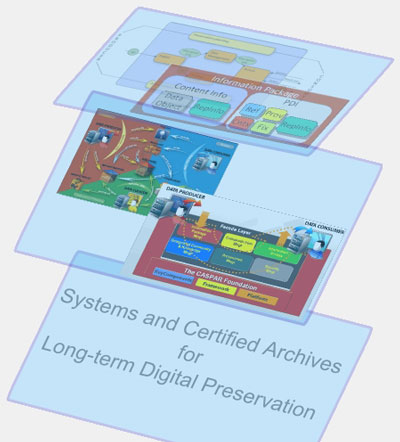We introduce a more concrete and detailed intermediate level for long-term digital preservation between the conceptual model of the Open Archival Information System (OAIS) and the real world of the certified archives.
Digital information innervates modern civilization, and yet it is extremely vulnerable. Precious digital information created and stored all over the world is becoming inaccessible at a very fast pace. At the same time, paper documentation is increasingly being converted into electronic format, with even more now being ‘born digital’. The availability of these electronic resources must be guaranteed for the future. Such reasons justify the need to acquire, preserve and maintain digital resources, so that the information contained in them may be always accessible and usable.
Much effort and activity has been dedicated towards digital preservation in recent years, but it still represents an open issue for research and development. Models, methodologies, approaches and prototypes have been proposed, and often solutions have been conceived and driven by the requirements of specific libraries and archives. However, the growing community of experts now recognizes and widely accepts the standard OAIS (Open Archival Information System; ISO:14721:2003) as the primary reference in this domain. Although OAIS itself is primarily a conceptual model and aims to standardize key concepts and mandatory responsibilities for any long-term archive, this reference model does not specify a design or an implementation. Hence, building a system that supports an OAIS-compliant archive requires the introduction of an intermediate level of detailed models and specifications. Following this, the implementation and prototyping should be evaluated (better if in different scenarios and domains) in order to validate the completeness and correctness of the models and specifications.
Such a process has already occurred during the European Integrated Project CASPAR (Cultural, Artistic and Scientific knowledge for Preservation, Access and Retrieval), which based modelling and specification activity on the OAIS reference model. In three years, CASPAR has addressed important and still open research issues in digital preservation by:
- extending the information model and investigating fundamental related aspects such as representation information (RepInfo), preservation description information (PDI), Designated Community knowledge base characterization and evolution, authenticity concepts and tools, digital rights management and rights evolution
- proposing revisions to OAIS
- identifying, designing and prototyping key components which deal with the main concepts of the OAIS information model and represent best practices for many important digital preservation issues
- raising awareness in a variety of other communities (ie cultural, artistic and scientific) of digital preservation issues and the importance of the OAIS standard
- undertaking impact analysis on the validation methodology for the preservation activities.

Figure 1: From OAIS to Certified Archives: the intermediate step provided by CASPAR.
The CASPAR approach has advanced the state of the art in digital preservation by enhancing and extending the OAIS standard, and this is its most important strength. In addition, by using the OAIS reference model, CASPAR has identified, specified and prototyped a framework and key components which could be applied in the digital preservation process and represent a valuable outcome to be reused for best practices, patterns, methodologies and references in the domain (for further details see the OSS community ‘Digital Preservation Services’ on SourceForge). It may reasonably be asserted that CASPAR has added an intermediate step between the abstract conceptual model provided by OAIS and the concrete world of digital preservation.
Links:
CASPAR: http://www.casparpreserves.eu
Development Community: http://developers.casparpreserves.eu
Please contact:
Luigi Briguglio
Engineering Ingegneria Informatica S.p.A, Italy
E-mail:
Carlo Meghini
Istituto di Scienza e Tecnologie della Informazione [ ISTI ], Consiglio Nazionale delle Ricerche [ CNR ]
E-mail:
David Giaretta
STFC, Rutherford Appleton Lab, UK
E-mail:










